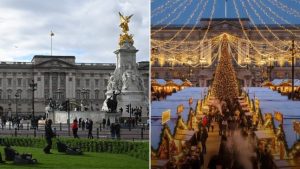What do Banksy’s art pieces across London mean? We take a look
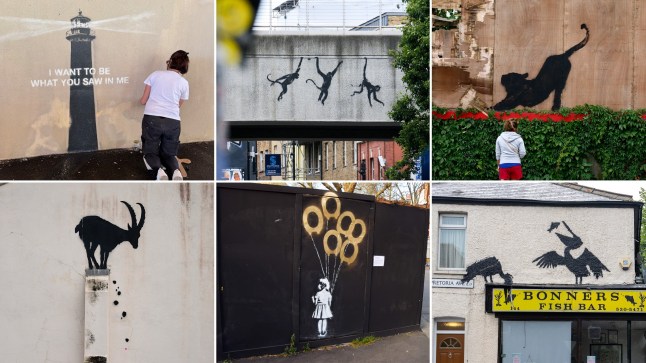

Last year, Banksy fans were left gripped after a series of animal-themed murals mysteriously appeared across London over a number of days.
The graffiti artworks – depicting the likes of a goat precariously balancing on a pillar with rocks falling below it, two elephants are poking their heads out of blocked windows and three monkeys swinging on a bridge – first cropped up on August 5.
The goat, which appeared on a building in Kew Road, west London, was the first piece to be created. Over the following eight days, a wolf, pelicans, a big cat, a rhino, piranhas and a gorilla were all stenciled on buildings in the capital. While some have since been removed, some of the pieces still remain in the city.
But what was the reason behind the elusive Banksy’s spurt of creative talent?
Earlier this year, the covert street artist also added two new pieces to the capital’s streets. One was a lighthouse, with the words ‘I want to be what you saw in me’ written across it.
Another was a little girl holding gold balloons in Clerkenwell Green, Farringdon, painted on top of boarded-up toilets.
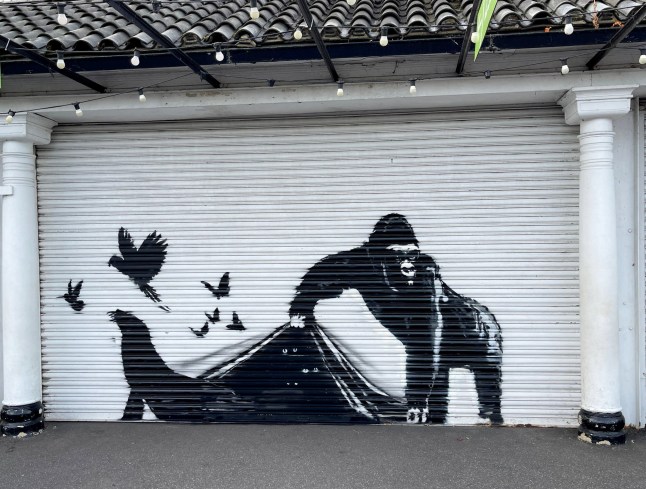
Paul Gough is an expert on Banksy and is a professor and vice chancellor at the Arts University Bournemouth.
He previously told Metro that the mysterious artist’s stretch of artworks could be pointing towards something significant. What the significance was, however, has yet to be revealed.
What was Banksy’s grand plan?
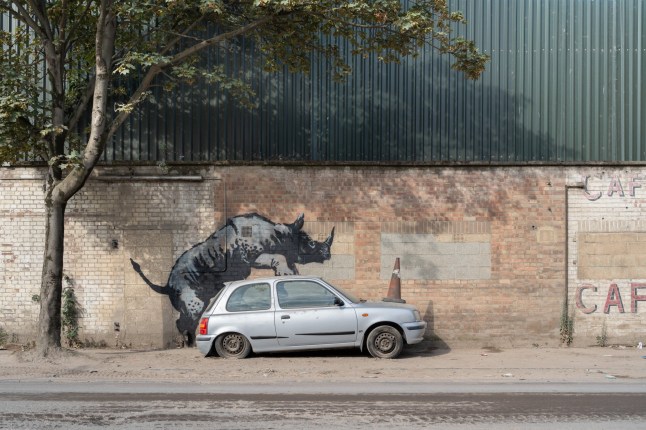
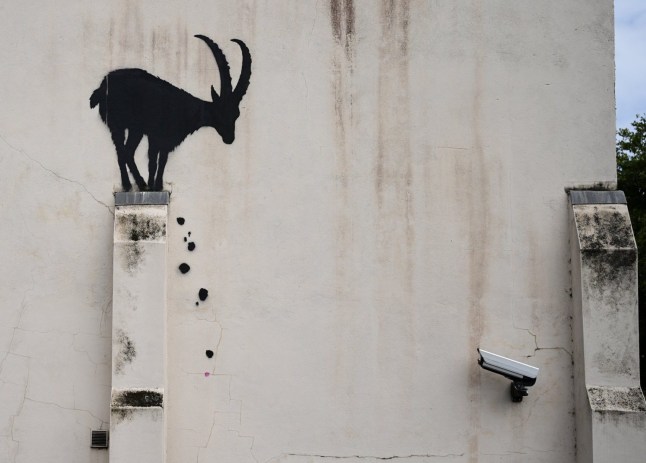
‘What’s different is that Banksy usually leaves it a bit of time, keeps people guessing whether a piece of work is authentically his,’ Gough said.
Latest London news
- Inside Heathrow’s latest £49,000,000,000 expansion plan for third runway and terminals
- London’s ‘quaint’ borough is the cheapest to rent at £1,485 — but it might not be for long
- Facial recognition cameras doubled in London despite ‘dystopian’ warning
To get the latest news from the capital visit Metro’s London news hub.
While Banksy hosted a month-long residency in New York City in 2013, in which he produced one street art piece in a different part of the city each day in October, this was advertised beforehand.
What did we know about the nine animal Banksy pieces?

The difference with the artworks in London is that Banksy confirmed he had created them almost immediately after Londoners spotted them.
The artist, whose identity has never been officially confirmed, usually waits several weeks or months to confirm that he has created certain pieces, leading to speculation and mock Banksys to appear.
The mountain goat artwork was removed in early 2025, leaving local residents ‘heartbroken’, while owners of the building described it as ‘essential’.
The second piece showed two elephants poking their heads out of blocked-out windows on Esther Terrace, Chelsea, west London and the third showed three monkeys swinging along a bridge on Brick Lane in east London, which were then removed in February of this year.
A lone wolf appeared on Rye Lane in Peckham, south east London, the day after, before being stolen just an hour later.
A fifth appeared in Walthamstow, showing two pelicans eating fish above Bonners Fish Bar on Northcote Road.
Then a cat on a dilapidated billboard, overgrown with leaves, popped up on Edgware Road in Cricklewood, northwest London, the following day.
In a break from silhouettes, Banksy then decorated the windows of a City of London Police box with a swimming school of piranhas on Ludgate Hill.
The City of London Corporation removed the box for safekeeping. It has yet to decide on a permanent home for the artwork.
The following week saw the arrival of a rhinoceros mounting a parked car on Westmoor Street in Charlton, south east London.
That one didn’t last long – someone was filmed in a balaclava spray painting over it days after it was created.
Then a painting of a gorilla freeing animals at London Zoo appeared, the final piece of the puzzle.
As was the case every day in early August last year, Banksy confirmed the artwork’s legitimacy on his official Instagram just after 1pm each day.
Gaugon added: ‘A pattern emerged underneath all this. Banksy certainly has used animals in his work in the past, but the difference is these have often been creatures like rats or chimps.
‘The animals used so far seem rather benign, quite innocent to the world bar the wolf, certainly a change from his previous work.’
The meaning behind Banksy’s London pieces
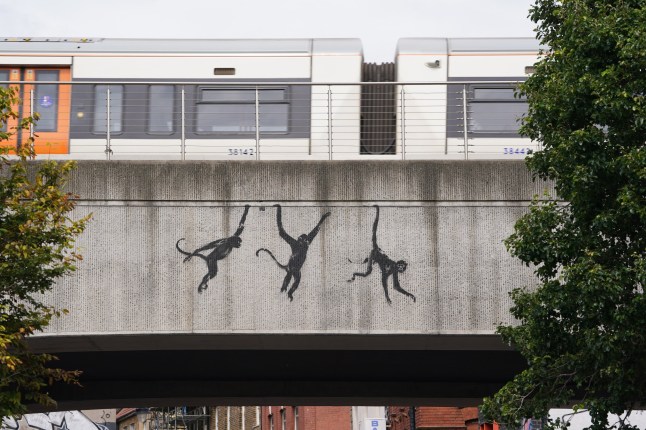
Desperate for an explanation, at least one person has speculated the artworks may be a commentary on immigration and refugees.
Another claimed it was about Brexit, pointing to the cat painted on a billboard, because billboards carried the ‘£350million for the NHS promise during the Brexit campaign’.
Writing under Banksy’s Instagram post of the piece, they said: ‘The cat out of the bag meaning the truth about Brexit. The cats symbolised the scratching of a billboard that’s gone to wrack and ruin, with the messages on it long gone.’
Sadly, just days after it was put up, the stretching cat piece was removed. Its whereabouts are unknown.
Gaugon told Metro he believes Banksy was inspired to create the animal series because of the state of the world.
He said: ‘Although there is so much going on, it is hard to pinpoint what he is specifically referring to at the moment.’
However, people may be overthinking the meaning, Banksy’s support organisation, Pest Control Office, suggested.
Instead, Banksy’s aim might be to cheer people up with ‘unexpected amusement’ amid bleak news headlines, The Observer reported.
Does the geography of the Banksy pieces matter?
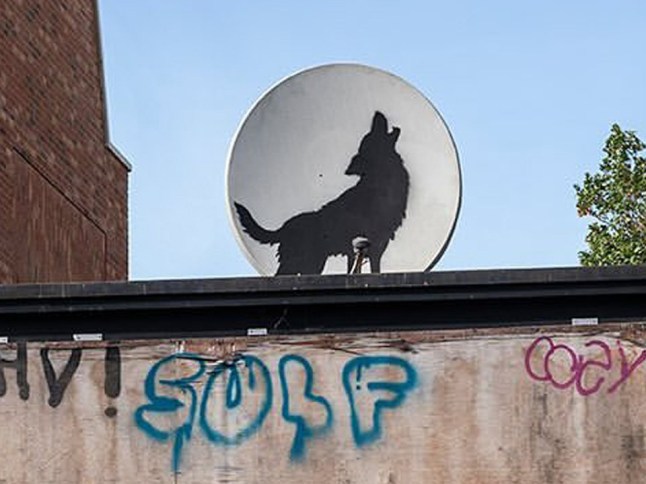

It doesn’t seem that Banksy chose these specific locations for a reason, but then again, we just don’t know.
Banksy has been known to create other art series and campaigns in August in specific geographical areas of the UK in the past.
One of the most famous was his Spraycation series across areas on the east coast of England in August 2021.
But it took Banksy a while to officially verify these ten pieces of work across towns including Cromer, Great Yarmouth, Lowestoft and Oulton Broad.
‘One thing is certain, Banksy works by his own rules and we are all dancing to his tune,’ Gaugon said.
Get in touch with our news team by emailing us at webnews@metro.co.uk.
For more stories like this, check our news page.
